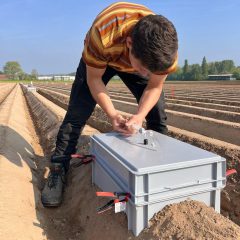Research project Early detection of quarantine plant diseases using image processing

Main research question
The overall objective of Nema Sensing is early detection of quarantine nematodes using remote sensing and image analysis. The research will determine the potential of these techniques at tuber and plant level for both root-knot nematodes (Meloidogyne chitwoodi and M. fallax) and potato cyst nematodes (Globodera pallida and G. rosochiensis).
Research approach
This project uses remote sensing technologies such as hyperspectral and thermal imaging to accurately and automatically detect nematode infestations. In a first stage, tubers and plants are monitored in controlled environments to exclude influences of other (a)biotic stresses. In a later stage, the developed techniques areapplied at field scale. The application of remote sensing technologies and image analysis is more objective and time efficient compared to visual inspections.
Relevance/Valorization
Plant-parasitic nematodes have a major impact on global food production. After their introduction into a field, effective management requires the detection of nematodes in the early stages of infestation with high spatial accuracy. The most straightforward method to detect infestations is visual examination of plant roots. However, this approach is invasive and impractical for large-scale use. Application of remote sensing technologies can address these problems and be utilized to detect plant disease at an early stage.









